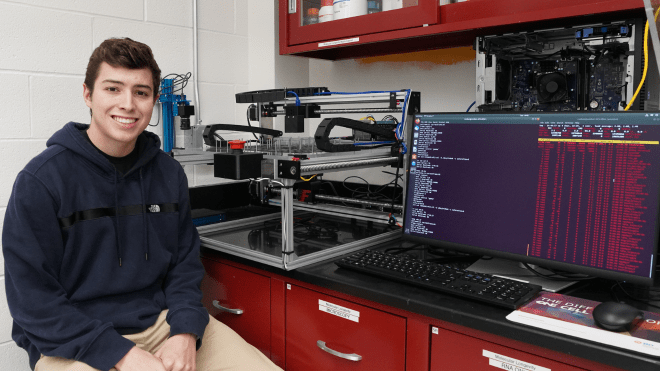Meet Roti-Bot, the Biology Lab’s Student-Designed Research Tool
A double major in Biology and Applied Mathematics, senior Colton Pelletier used his interdisciplinary education to construct the Roti-bot to aid in studying molecular longevity

BRISTOL, R.I. – Piece by piece, wire by wire, Colton Pelletier built a robot in the Molecular Longevity Laboratory in the basement of the Marine and Natural Sciences building during the summer after his sophomore year at Roger Williams University. For the next two years, Pelletier has continued to work on this research project to document the life span of rotifers, an important microscopic, aquatic animal.
When Pelletier, now a senior, was applying to colleges, he knew he wanted to study Biology. He also had a passion for numbers and equations. When he discovered that he could double major in both Biology and Applied Mathematics at Roger Williams, he said it opened a whole new world of opportunities.
One of these opportunities came in the form of a research project that allowed Pelletier to build and develop a robot that he dubbed Roti-bot, named after rotifers, the organism it documents. Pelletier based his original concept on a similar robot, called the WormBot, designed by scientists at the University of Washington to automatically capture photos of the lifespan of C. elegans. The Roti-bot is adapted to capture photos of rotifers via 3D prints.
“The entire first summer I was just adapting this robot, getting it set, and trying to get it to function the way we wanted it to,” he said. “I learned a lot about problem solving."
The goal of Pelletier’s robot is to document the life span of rotifers, a microscopic aquatic invertebrate that serves as a major food source and contributes to the decomposition of soil organic matter. Rotifers have a genome that is relatively similar to humans, making them ideal model organisms to study in RWU’s Molecular Longevity Laboratory. The life spans of these rotifers are subjected to different treatments including pharmaceuticals from an FDA-approved drug library, Pelletier said.
“The big picture is that if we can find treatments that extend the life span of rotifers, they might be able to extend the life span of humans. Rotifers only live about three weeks, so we can get results quickly,” he said.
The Roti-bot is designed to automatically take a photo of rotifers every 30 minutes, document the organism’s entire life span. The robot takes thousands of photos during the organism's lifetime, and Pelletier said he learned how to write code that will produce life span data to summarize the organism's full life span.
The robot contains a camera system with a flash that is positioned above a plexiglass optical table, which is where Pelletier places his rotifer samples, he explained. The device can survey 720 rotifers at once. His robot tracks each rotifer in the sample, moves its camera system directly over it and takes one photo, waits five seconds, and takes a second photo before moving on to the next. This process is repeated until every sample has been photographed twice. At the conclusion, the robot moves back to its starting position and waits 30 more minutes until the process begins again. After a rotifer dies, the photos are compiled into a time-lapse that’s analyzed to calculate how long each rotifer lived.
Pelletier, from Bristol, Conn., began working on Roti-bot during his sophomore year, as part of a summer research project funded by the Rhode Island Institutional Development Award Network of Biomedical Research Excellence (RI-INBRE). His faculty advisor, Assistant Professor of Biology Christopher Burtner, who leads the Molecular Longevity Lab at RWU, reached out to Pelletier about the opportunity to participate in his lab and design the robot.
Burtner emphasized the importance of understanding both the statistical aspects of biology projects and the science behind mathematical problems. He said Pelletier's interdisciplinary coursework enabled him to work on the project more independently, as he possessed the necessary knowledge and had connections in both topics.
“He’s taken the leadership to find the kind of resources needed to make the robot perform its function,” Burtner said. “Research is challenging – not in an academic sense. It's challenging in an emotional sense because there are a lot of hiccups and failures and questions about what just occurred, how to fix it, and how to best leverage resources. And that's why Colton has been very good at this project.”
For the Applied Mathematics side of his research, Pelletier is working with Assistant Professor of Mathematics Hum Nath Bhandari to use machine learning and data science techniques to describe, model, and ultimately predict rotifer life span. Their collaborative work aims to build a you-only-look-once (YOLO) object detection and classification model based on convolutional neural networks (CNN) that recognizes and documents the organism’s life cycle. Pelletier will be presenting his research at the Joint Mathematics Meetings in San Francisco, Calif., in January 2024.
"Colton has always been consistent, enthusiastic, and focused during our research meetings. He ardently desires to learn new skills and refine his mathematical and computational knowledge,” said Bhandari. In addition, “Colton brings new innovative ideas to each research meeting and asks, ‘Are we on the right track to complete the research on time?’”
Pelletier credits the small class and lab sizes at RWU for this opportunity. “If you put yourself in the right position, someone is going to be there to help you and reach out to you. You won’t get lost in the crowd,” he said.
By combining Biology and Applied Mathematics, and soon adding a certificate in Biotechnology, Pelletier created his own custom path and set himself up to soar into to the next chapter on his academic journey. Along with three other students, he continues to work on studying genetic longevity in Burtner’s lab. After he graduates in May, Pelletier said he wants to pursue a graduate degree in the biomedical sciences.
As for Roti-bot, it will remain at RWU for students to use and update for years to come.